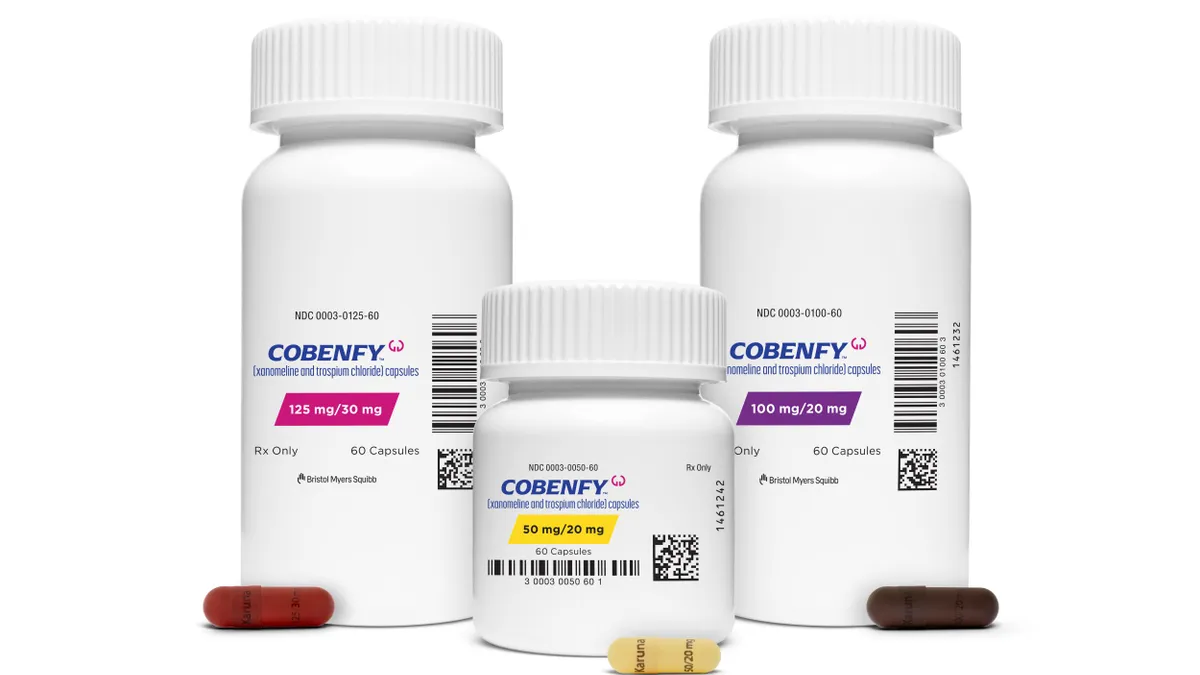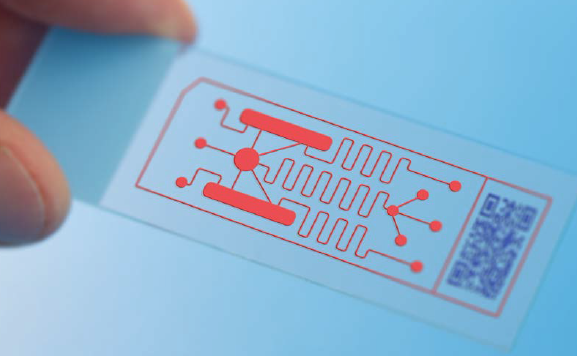 One day, precision medicine will take into account the genes, environment, and lifestyle of each person. Through the use of an emerging technology that melds engineering, biology, and IT, researchers are able to see what hasn’t been possible before: the inner workings of human biology and disease.
One day, precision medicine will take into account the genes, environment, and lifestyle of each person. Through the use of an emerging technology that melds engineering, biology, and IT, researchers are able to see what hasn’t been possible before: the inner workings of human biology and disease.
This new technology is just starting to be developed by several companies in the emerging lab-on-a-chip field, which eventually will allow for a new understanding of the way our cells respond both in healthy states and in disease states.
A tissue or an organ-chip is a living, micro-engineered environment that recreates the natural physiology and mechanical forces that cells experience within the human body. These devices are being designed to be accurate models of the structure and function of human organs, such as the lung, liver, and heart. Once integrated, researchers will be able to use these models to predict whether a drug candidate, vaccine, or biologic agent is safe.
For pharmaceutical companies, this technology offers tremendous potential for predicting side effects and efficacy. Failure to demonstrate efficacy accounts for about 65% of drug failures during clinical trials, and about 30% of promising medications have failed in clinical trials because they are found to be toxic despite promising animal studies, according the National Institutes of Health.
 Misti Ushio, Ph.D., CEO of Tara Biosystems, a company developing cardiac tissue models, says one of the driving factors behind organs on chips is the interface between biology and engineering.
Misti Ushio, Ph.D., CEO of Tara Biosystems, a company developing cardiac tissue models, says one of the driving factors behind organs on chips is the interface between biology and engineering.
“This interface, coupled with what’s happening in stem cell science, is enabling these technologies, which is very exciting," she says.
The NIH sees such potential in this lab-on-a-chip technology, that NIH’s National Center for Advancing Translational Sciences (NCATS) is supporting a Tissue Chip Drug Screening program and in October 2016 announced a new funding opportunity for the next phase of this program.
The Center and its collaborators plan to commit an estimated total of $13.5 million in fiscal year 2017 for 10 to 12 awards.
“One of the advantages of organ-on-chips technology is that it gives us a level of functionality and control of the biology in a way that hasn’t been seen before," says Geraldine Hamilton, Ph.D., president and chief scientific officer of Emulate, a company developing a lung chip. “We can now use the technology to better predict the effect a drug will have in a human biological system. We can better predict human response to a drug before it gets into the clinic and fails."
Dr. Ushio explains that these technologies have the ability to impact multiple points along the development cycle.
“We have the opportunity to create a more complete biology data set for evaluating new therapies as well as looking at the safety of new therapies," she says. “Pharma companies can also start thinking about how they can use these technologies to better stratify patient populations for clinical trials, and what they can do beyond that in terms of personalized cardiology treatment, for example."
But while there has been a tremendous amount of advancement in lab-on-a-chip systems, they are not yet at a point to be truly predictive of human response.
Rob Freedman, CEO of Hurel Corp., says organs-on-a-chip is a dazzling new technology category, full of promise and, moreover, it sounds cool, but the question one must answer is how that coolness does or does not translate into reduced 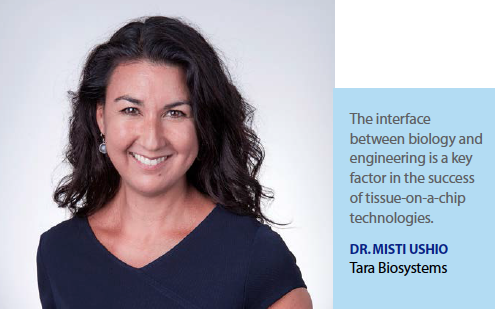 candidate attrition in the real world of drug development.
candidate attrition in the real world of drug development.
“Late-stage attrition is the killer because it chews up the available R&D bandwidth of a company with compounds that are mostly going to fail," he says. “Not only that, pipelines are full of that latent failure for long periods of time, which means a large pharma is financing dozens of latent failures at its long-term cost of capital. If organs-on-a-chip don’t help reduce that problem — and do it cost-effectively — they are just a very glittery academic fantasy."
For this chip technology to be truly useful for predicting human response, there needs to be a convergence with more sophisticated tissue architecture.
“The fields of fluidics and 3D bioprinting are converging," says Sharon Presnell, Ph.D., chief scientific officer, Organovo, a company that creates functional, 3D human tissues for use in medical research.
“3D tissues on the biology side will become interconnected with fluidics technologies," she says. “Within five years, we could see systems that have highly intelligent, highly ordered tissues connected to each other by a physiologically meaningful flow."
Linking disparate tissues could lead to simulations similar to those being used in animals, says J. Lowry Curley, Ph.D., CEO of AxoSim Technologies, a company developing nerve-on-a-chip technology.
“By linking these tissue systems outside a living organism, we can get closer to a point where we have enough complexity to understand the biology," he says.
The fluidic advancements and evolutions in other chip technologies are teaching researchers a lot about how to introduce fluid flow in a way that resembles humans.
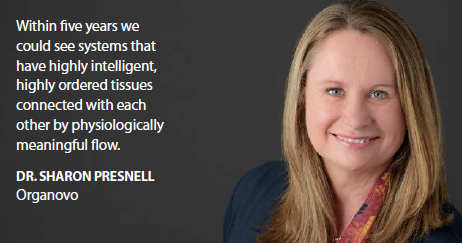 Dr. Presnell says in the 10-year timeframe, researchers will be able vascularize larger tissue structures that might be useful for regenerative medicine and implantation. She says the fluidics field and the 3D bioprinting field will co-evolve and borrow from each other to solve the problems that need to be addressed to create these integrated systems.
Dr. Presnell says in the 10-year timeframe, researchers will be able vascularize larger tissue structures that might be useful for regenerative medicine and implantation. She says the fluidics field and the 3D bioprinting field will co-evolve and borrow from each other to solve the problems that need to be addressed to create these integrated systems.
One challenge, however, is scale. Tissues created from 3D bioprinting are too large for the chips being developed now. And to make the tissues viable for pharma scientists, they will need to be relatively simple to use.
“Our customers see the value of the histology, and they want the ability to ask the types of questions that would be impossible to answer in a typical clinical trial setting," Dr. Presnell says. “Having greater understanding of the biology as part of the equation is going to be a game changer."
Lung, Heart, Liver and Nerves on Chips
Companies in this space are using different approaches and different cell types to develop their tissue chips. Emulate, for example, is integrating its Organs-on-Chips technology into a lab-ready system, called the Human Emulation System, that can be easily operated by researchers and fits into their laboratory work flows. Emulate has a portfolio of organ-chips that work in the system, with established organ-chips for the lung, liver, intestine and kidney, and emerging functionality for the skin, heart and brain.
Each of Emulate’s organ-chips is a living, micro-engineered environment that recreates the natural physiology and mechanical forces that cells experience within the human body.
In October 2016, the company expanded its Series B financing with an additional $17 million in equity funding, bringing the total amount raised to $45 million.
The funding is being used to augment the translation of Emulate’s technology into a commercially available Human Emulation System. The lab-ready system will include three components: organ-chips, instrumentation, and software apps.
“These three components enable us to have the right throughput, the right capacity, and the robustness to test different drugs in drug discovery and development," Dr. Hamilton says.
The organ-chips contain tiny hollow channels lined by human cells and are designed to recreate the smallest functional unit of an organ within a micro-engineered environment that realistically emulates the human body.
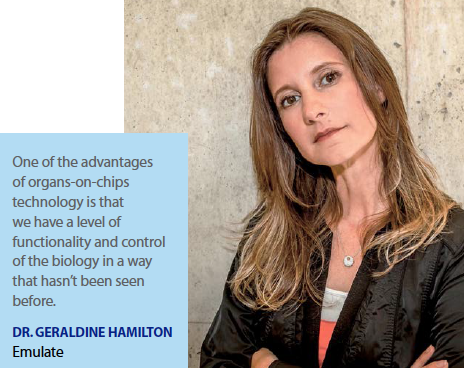 “This is a micro-engineered technology, in which we combine design, engineering, and biology to recreate what we refer to as ‘a home away from home’ for the cells," Dr. Hamilton says. “Micro-engineering allows us to give the cells all the right cues so they can function appropriately and they can function akin to what they would experience in the human body."
“This is a micro-engineered technology, in which we combine design, engineering, and biology to recreate what we refer to as ‘a home away from home’ for the cells," Dr. Hamilton says. “Micro-engineering allows us to give the cells all the right cues so they can function appropriately and they can function akin to what they would experience in the human body."
The chips are fluidic in nature. They function similar to how cells would experience life inside the body, providing nutrients as well as taking away waste products.
“Our goal with the chips is to emulate human biology so that we can better predict how medicines, food, and chemicals as well as diseases will affect human health," Dr. Hamilton says.
Emulate has a collaboration with Merck to deploy the Organs-onChips technology across certain Merck discovery programs to improve models of human inflammatory diseases and better predict the potential human response of therapeutic candidates. The collaboration will initially focus predictive modeling of inflammatory processes in the human lung and the gastrointestinal system.
Emulate also has a collaboration with Janssen Biotech through the J&J Innovation Center to deploy the organs-on-chips technology across certain Janssen programs. The collaboration will evaulate at three Janssen R&D programs at the stages of drug candidate design and selection. Using Emulate’s Thrombosis-on-Chip, Janssen research teams are evaluating the potential for drug candidates to cause thrombosis, a potential side effect of certain drug classes such as immuno-therapeutics and oncology drugs.
Tara Biosystems, another company in this space, is developing cardiac tissue models. Tara uses human stem cells to produce heart tissue. The company’s Biowire II platform produces mature heart tissue that better mimics adult heart tissue and enables changes in cardiac function to be measured. The platform can measure changes in heart rate, the force of the heartbeat, the heart’s electrical signal, and calcium levels fundamental to heart function.
The platform can be used to help pharmaceutical companies identify cardiac complications early in the development of new medicines. The system can also generate diseased heart tissue, which allows the testing of medicines for specific disease.
The company is using advances in stem cell sciences and tissue engineering to create heart tissue in a dish that better mimics the adult heart, Dr. Ushio says.
“The idea is that we’ll be able to get a much earlier read on the efficacy and the safety of new medicines in the development process," she says. “We mature the cardiac cells using electrical and mechanical stimulation, and by doing so we are able to create heart tissue in our platform that is more like adult heart tissue, which can provide a better understanding of the positive and negative effects new medicines in developement may have on cardiac functionality."
Dr. Ushio says the company is cell agnostic, obtaining cardiomyoctyes from a variety of sources that are then matured into heart tissue.
Hurel is a privately held company that develops microlivers and cell-based microfluidic tools. The company’s self-assembling microlivers are primary hepatocyte co-cultures of the human, dog, rat, mouse, mini-pig, or monkey species.
Hurel’s HµRELflow microfluidic platform is a disposable, two-tissue biochip that combines with a docking station to recirculate liquid culture media much as the bloodstream interconnects a body’s organs. The system, which partners microlivers with heart, kidney, lung, or other tissue cultures, will be available in beta-test format in 2017, Mr. Freedman says.
AxoSim is another company developing lab chips for nerves, but it is not using use fluidics. Employing micro-engineering techniques and novel biomaterials, the company’s nerve-on-a-chip technology is a 3D scaffolding system that allows for the engineering of living stem cells into a 3D environment.
“We can culture and grow these nerves on a chip so that the nerve essentially matures and looks like a real nerve in the human body," Dr. Curley says.
The company uses commercial sources for cells and then isolates the neurons and supportive cells. These nerve fibers are allowed to grow in an area on the chip so that they can be viewed in 3D as they would in the body."
Dr. Curley says the company is working with pharma company partners to do toxicity testing on nerves the sponsors are unable to do using traditional testing methods. AxoSim is also working with pharma partners to model neurodegenerative diseases and expand its portfolio. (PV)





